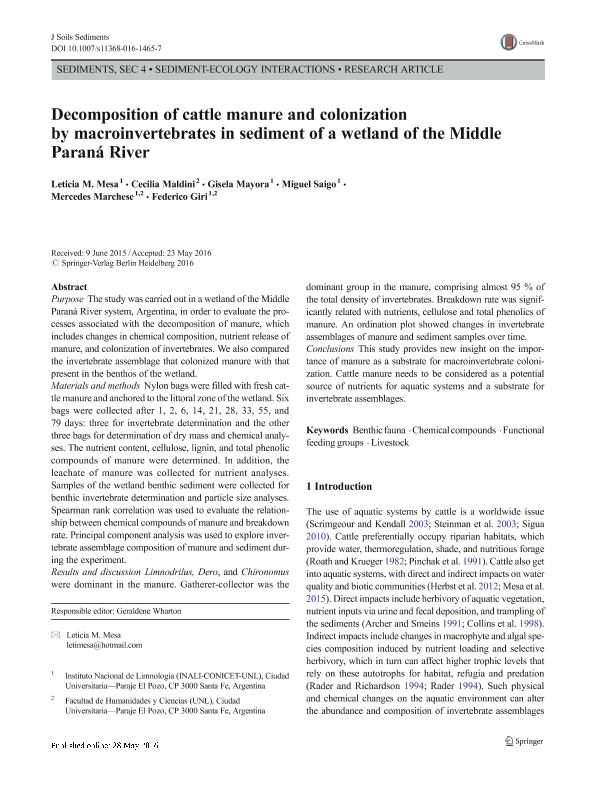Artículo
Decomposition of cattle manure and colonization by macroinvertebrates in sediment of a wetland of the Middle Paraná River
Mesa, Leticia Mariana ; Maldini, Cecilia; Mayora, Gisela Paola
; Maldini, Cecilia; Mayora, Gisela Paola ; Saigo, Miguel
; Saigo, Miguel ; Marchese Garello, Mercedes Rosa
; Marchese Garello, Mercedes Rosa ; Giri, Federico
; Giri, Federico
 ; Maldini, Cecilia; Mayora, Gisela Paola
; Maldini, Cecilia; Mayora, Gisela Paola ; Saigo, Miguel
; Saigo, Miguel ; Marchese Garello, Mercedes Rosa
; Marchese Garello, Mercedes Rosa ; Giri, Federico
; Giri, Federico
Fecha de publicación:
09/2016
Editorial:
Springer Heidelberg
Revista:
Journal Of Soils And Sediments (print)
ISSN:
1439-0108
Idioma:
Inglés
Tipo de recurso:
Artículo publicado
Clasificación temática:
Resumen
Purpose: The study was carried out in a wetland of the Middle Paraná River system, Argentina, in order to evaluate the processes associated with the decomposition of manure, which includes changes in chemical composition, nutrient release of manure, and colonization of invertebrates. We also compared the invertebrate assemblage that colonized manure with that present in the benthos of the wetland. Materials and methods: Nylon bags were filled with fresh cattle manure and anchored to the littoral zone of the wetland. Six bags were collected after 1, 2, 6, 14, 21, 28, 33, 55, and 79 days: three for invertebrate determination and the other three bags for determination of dry mass and chemical analyses. The nutrient content, cellulose, lignin, and total phenolic compounds of manure were determined. In addition, the leachate of manure was collected for nutrient analyses. Samples of the wetland benthic sediment were collected for benthic invertebrate determination and particle size analyses. Spearman rank correlation was used to evaluate the relationship between chemical compounds of manure and breakdown rate. Principal component analysis was used to explore invertebrate assemblage composition of manure and sediment during the experiment. Results and discussion: Limnodrilus, Dero, and Chironomus were dominant in the manure. Gatherer-collector was the dominant group in the manure, comprising almost 95 % of the total density of invertebrates. Breakdown rate was significantly related with nutrients, cellulose and total phenolics of manure. An ordination plot showed changes in invertebrate assemblages of manure and sediment samples over time. Conclusions: This study provides new insight on the importance of manure as a substrate for macroinvertebrate colonization. Cattle manure needs to be considered as a potential source of nutrients for aquatic systems and a substrate for invertebrate assemblages.
Palabras clave:
Benthic Fauna
,
Chemical Compounds
,
Functional Feeding Groups
,
Livestock
Archivos asociados
Licencia
Identificadores
Colecciones
Articulos(INALI)
Articulos de INST.NAC.DE LIMNOLOGIA (I)
Articulos de INST.NAC.DE LIMNOLOGIA (I)
Citación
Mesa, Leticia Mariana; Maldini, Cecilia; Mayora, Gisela Paola; Saigo, Miguel; Marchese Garello, Mercedes Rosa; et al.; Decomposition of cattle manure and colonization by macroinvertebrates in sediment of a wetland of the Middle Paraná River; Springer Heidelberg; Journal Of Soils And Sediments (print); 16; 9; 9-2016; 2316-2325
Compartir
Altmétricas



